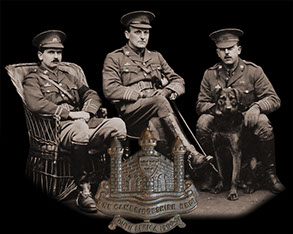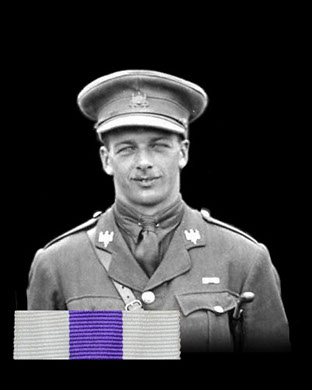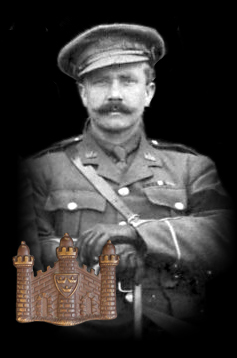
Who Were
The Cambs
The Cambs
at War
1/1st Btn 1914-1919
1914 - 1/1st Overview
1915 - 1/1st Overview
1915 - St Eloi
1915 - Fosse Wood
1916 - 1/1st Overview
1916 - The Schwaben
1916 - St Pierre Divion
1917 - 1/1st Overview
1917 - St Julien
Insignia, Medals & Books
Remembering The Cambs
Biographies
About Us &
This Site
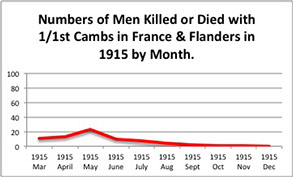
Menu of 1915 Related Pages
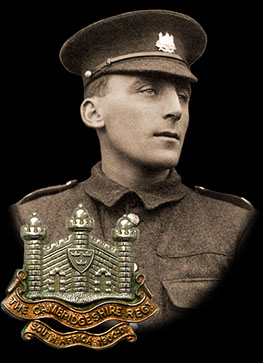
Cpl Noble Dewey, killed 4th March 1915.
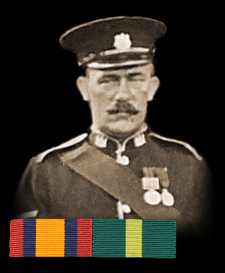
Sgt Bowyer of the Machine Gun Section.
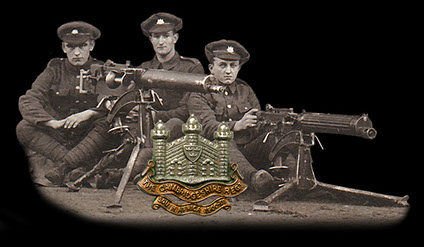
Cambs Maxim and Vickers machine gunners.
1915
January
As the New Year began the men of the Cambs were well aware that departure for France was imminent. Training was relentless despite the cold winter, the training program was still interrupted at times and the men spent several days on guard throughout Suffolk. In late January the Battalion was reorganised to bring it in line with the standard layout for an overseas battalion. The old eight Coy system was changed to a four Coy system by merging two together (A & B merged to form A, C & D to form B and so on). The Battalion naming was also changed and they now became the 1/1st Battalion, The Cambridgeshire Regiment. In late January it was confirmed the Cambs would be heading to France soon and leave was granted to many of the men.
February
Orders giving the date they were to leave finally came through to the Cambs during the first week of February. It was a time of great excitement and activity as everything was prepared and organised. More leave was given to many of the men. The 1/1st Cambs finally left Bury St Edmunds in three trains around 6am on Sunday 14th February and headed to Southampton. By late evening the men were all embarked and they crossed the Channel during the night. By first light the next day the ships were at Le Havre and the men were all disembarked by early afternoon.
The Cambs were given order to join the 82nd Brigade, 27th Division. The Division was mostly made up of Regular Army battalions rushed back to Europe from garrison duties around the Empire and had been in France since Christmas. The 1/1st Cambs left the Le Havre area after several days and spent just over a week training and trench digging around Terderghem. On the 28th they moved to Boeschepe, behind the lines of the Ypres Salient and plans were made to start getting the men used to the front line.
March
B Coy under Maj Saint was the first to experience the front line, on the 2nd March it was moved up to Dickebusch and used for trench digging just behind the front line. While carrying out this duty on the 4th March they suffered the first casualty to the enemy. Pte J. Northfield was wounded in the arm and a short while later Cpl N. Dewey was hit in the chest and died of his wounds.
Over the next week the Battalion was acclimatised to life around the front line and spent more time digging around Voormezeele. On the 13th March the MG Section was moved into the front line at St Eloi to gain experience. The next day one officers and one sergeant from each Coy were also sent to the front line for a tour of that area of the front line. These men were still in the front line on the 14th March when in the afternoon the Germans detonated a large underground mine beneath a feature known as "the Mound". This was the signal for a large scale German attack and intense artillery barrage.
After the shock of the mine explosion and German assault, sections of the line were lost and the men were pushed back. The rest of the Cambs were quickly brought up to strengthen and help hold the new line. The Cambs MG teams in the front line were in the thick of the fighting and proved themselves to be skilled in their trade. For a more detailed account of the Cambs in action at St Eloi on the 14th - 15th of March please click here.
Sadly though there were casualties. Lt Smalley a pre-war officer from the Whittlesey Coy was killed at the Mound and Sgt French who was with him was taken PoW. Capt O Tebbutt was also killed along with three other ranks and numerous men were wounded. The Cambs had been bloodied but had proved themselves. In the weeks following the St Eloi attack the Cambs spent time resting behind the lines at Westoutre.
April
On the night of the 2nd April the Cambs were moved up into the front lines around Sanctuary Wood. This was to become an area of the Ypres Salient that would become very familiar to the Cambs. A wooded copse nearby was quickly dubbed "Cam Grove", a name that stuck for the rest of the war. Over the next several weeks the Cambs spent time in the line or in the dugouts around Sanctuary Wood, casualties from snipers and artillery started to rise.
The German Army launched its first large scale gas attack of the war on the 22nd April. Luckily for the Cambs this attack was just off to their left flank and their section of the line held. During this time of intense fighting in the Salient the Battalion's Transport Section worked tirelessly to bring up food and supplies to the men at the front. More information on the Transport Section and its members during this time can be found here.
The CO, Lt Col Copeman, was struggling with sciatica in the damp conditions and on the 25th he returned home. He was replaced as CO by Maj Archer.
May
Due to the successes of the German attacks on the Salient over the previous weeks the trenches around the Cambs were in danger of being cut off. On the night of 3rd May the line was abandoned and the men were pulled back to a new line closer to Sanctuary Wood. A few days later on the 6th May a further German attack around Hill 60 led to C Coy being ordered to move and secure an area known as Fosse Wood. Holding the wood was necessary to secure the newly established line should Hill 60 fall but it was to prove a terrible move for the Wisbech and Whittlesey lads of C Coy.
As C Coy moved from the cover of Armagh Wood they were caught in the open by artillery and MG fire from the Germans on Hill 60. Losses mounted rapidly as the men struggled to find any cover they could. The position at Fosse Wood was finally reached and some old abandoned trenches provided some shelter. The accurate enemy fire continued and many of the wounded could not be reached until nightfall. With the darkness also came the order to pull back, the situation had stabilised and Fosse Wood now did not need to be held. For a more detailed account on the shelling at Fosse Wood please click here.
The Cambs remained in the area around Sanctuary Wood until the 22nd May when they were moved to Busseboom just east of Poperinge. They remained there for several days in case there was a German breakthrough in the Salient. On the 26th May the battalion left the Ypres Salient and headed for Armentieres. They arrived there on the 28th and went straight into the front line. For a more detailed account of the Cambs time at Armentieres please click here.
June
Armentieres was a different world after the Salient, it was often referred to as the "softest place in France". It was an area of the line where sniping was key and despite casualties the Cambs quickly gained the upper hand. However improvements in German rifle grenades led to a growing list of casualties in the Battalion towards the end of the month. Early on in the Battalion's stay in the area they suffered a heavy blow when a popular and very brave young officer, named Hopkinson, was killed whilst on a trench raid, more information on these raids can be found by clicking here.
July
The casualties to rifle grenades continued to mount in the first two weeks of July including several officers such as Lt Crookham. On the 15th the Battalion moved to Bois Grenier, just down the line. Once again the Cambs snipers gained control.
August
The month of August was spent in the trenches around Bois Grenier or behind the lines resting and carrying out various duties with the Royal Engineers. Despite the quiet nature of the area there were still several casualties either to snipers or rifle grenades.
September
After a further two relatively quiet weeks in the area, the Cambs left the Armentieres area and headed for Morcourt on the banks of the River Somme. They entered the line in the last week of September and spent a great deal of their time assisting the REs who were busy tunnelling.
October
Much of October was spent either in the trenches or various duties with the RE and other working parties carrying out road construction. Casualties were very light but several men were still lost. The Cambs left the trenches on the 25th after being relieved by a French Regiment and headed to Thieulloy L'Abbaye near Amiens.
November
The Battalion spent November away from the front line. Early in the month it became apparent why the Cambs and the rest of the 27th Division had been removed from the front. The 27th was leaving France and heading to Salonica. Orders were also given for the Cambs and two other battalions to leave the Division and remain in France. The rest of the month was spent trench digging. Rumours surrounding the future of the Cambs were rife. This period of uncertainty was brought to an end quickly when the Battalion arrived at Flixecourt on the 30th November. The Battalion had been selected as the Training Battalion for the 3rd Army School. For a more detailed look at the Cambs time at the 3rd Army School and Flixecourt please click here.
December
In being selected as the Training Battalion the Cambs had had a real stroke of luck. Their role at the school was both learning, demonstrating and testing all manner of attacks and new techniques. The training was intensive and demonstrations for various high ranking officers were common place. In was however giving the men superb knowledge and training, something that would help them greatly in the future. December was spent carrying out drills and demonstrations most days. In the evenings the men billeted around Flixecourt were free to go to the local cafes and bars.

This site went live on the 14th February 2015 to mark 100 years since the 1/1st Cambs went off to war.
WE WILL REMEMBER THEM
Email us: cambsregt@gmail.com
Copyright 2015, 2016, 2017, 2018, 2019 by Felix Jackson. The information and images on this site should not be reproduced without prior permission.
